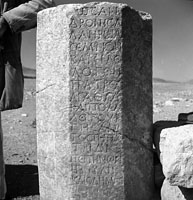 MAMA XI 307 (Perta)
MAMA XI 307 (Perta) 
Honorific statue-base for Sosandros
[Σ]ώσαν-
δρον Ἰόλ-
λα ἥρωα
σεμνὸν
5καὶ φιλό-
λογον
πατρὸς
ἀγαθοῦ
καὶ πολλὰ
10λειτουρ-
γήσαν-
τος τῇ πα-
τρίδι hed.
Περτηνῶν
15ἡ βουλὴ
καὶ ὁ δῆμος.
The council and the people of the Pertenoi (honoured) Sosandros son of Iollas, deceased, noble and learned, son of a good father who performed many liturgies for his homeland.




This monument was published in MAMA VIII, with two minor errors of transcription, without facsimile or photograph (noted, and regretted, by Robert, Hellenica XIII, 48). In 1956, Ballance photographed the stone in the village of Koçaş, on the basis of which we republish it here. As comparison of the photographs will show, the physical form and dimensions of this monument are effectively identical to those of MAMA XI 306 (1956/159: Küçük Boruk [Yenikuyu]), and it seems reasonable to assume that the two texts are precisely contemporary. Both columns presumably served as the bases for posthumous honorific statues, one public, the other private. For the form of both monuments, compare MAMA IV 52 and 63 (two hexagonal columnar statue-bases from Synnada, dating to the late second and early third century AD respectively); Lane 1971-8: I 102-5, nos. 164-7 (four hexagonal columnar statue-bases from Antiocheia by Pisidia); Drew-Bear 1978: 94-5, no. 31 (SEG 28, 1145: octagonal funerary pillar from Eumeneia).
For the term σεμνός as applied to men, compare MAMA XI 284 (1956/129: Zengicek/Koçyaka), with commentary; 303 (1957/40: Karakaya). Lykaonian φιλόλογοι are discussed by Robert, Hellenica XIII, 45-54; cf. BE 1974, 573; Weiss 1990; Ma 2007: 106-7. This monument is one of only three epigraphical texts to provide us with the ethnic of Perta, the others being the twin texts MAMA VIII 270 (Obruk) and MAMA XI 310 (1956/162: Koçaş). The ethnic here is Περτηνός; in the sixth-century texts MAMA VIII 270 and MAMA XI 310 it is Περτεύς. For the ethnic variation -εύς/-ηνός, cf. Habicht 1975: 76 (Βλαυνδεύς/Βλαυνδηνός); TAM V 3, 1871, commentary (Φιλαδελφεύς/Φιλαδελφηνός); Fraser 2009: 191-200.